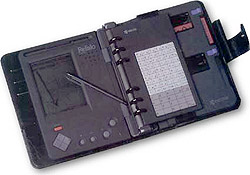 |
|
|
What's new in my pocket computers pages?
Friday, October 15th : Ricoh RDC i-700 received
Device securised this morning! No page for it yet; will be one some day.
Wednesday, September 15th : Sharp MI-10 added
Created a page for the Sharp MI-10 i've received.
Friday, July 23rd : new homepage, new machines listed
My collection reached 49 units yesterday as i've received 2 new watches. Added them to the list (no pages yet) and changed the homepage to a weblog format.
|
|
 |
|
 |
 This feature will soon be available
This feature will soon be available
|
 |
|
|
Kyocera Refalo KX 1601
With "Refalo Mail" PCMCIA card
PDA
|
** THIS ITEM IS NOT FOR SALE! **
IF YOU ARE LOOKING FOR A USER MANUAL
or IF YOU ARE LOOKING FOR A RESELLER/REPAIR STATION,
I'm sorry, but I will not reply to user manual requests or to dealer location inquiries anymore.
Please read my FAQ page that might help you if you have any of these questions in mind.
Feel free to contact me for any other question or comment regarding this machine!

This photo comes from a magazine; my Refalo does not have the keyboard-page extension that can be seen on this picture.
Special features :
- Runs MS-DOS
- A very interesting design
Weak points :
- The rubber coating is pretty fragile
- Sign of the times, the device is huge, although it makes a better use of it's size than many others
Related machines in my collection :
PDAs from the following generation:
 Sony Magic Link PIC-1000 Sony Magic Link PIC-1000
 Apple Newton Message Pad 110 Apple Newton Message Pad 110
 HP OMNIGO 100 HP OMNIGO 100
 Casio Z-7000 ZOOMER Casio Z-7000 ZOOMER
PC-oriented PDA :
 Atari Portfolio Atari Portfolio
|  |
At the time i write this page (July 2003); Kyocera is announcing a new Java based PDA in Japan.
Let's wish Kyocera the same success Sony has met with their entry in the Palm-OS market!
Just like Sony, Kyocera also released a very unusual machine during the dinosaur era of the PDAs. To be perfectly fair to the Refalo, i'd say i've seen references to it back in 1991, which was even earlier the Newton was released.
The Kyocera Refalo is thus quite a dinosaur. Quite an obscure machine, too, especially outside Japan; this machine is nevertheless full of good ideas.
Let's begin with the main design concept. Instead of creating a brick-like device with no other use than being a heavy PDA; Kyocera came up with the idea of actually integrating the PDA in the everyday life as an improved every-day object. The Refalo will then be a Smart Filofax. I like this idea a lot... Kyocera also brought this idea further that just disguising a PDA as a Filofax : they used a very smart electric induction system so that the Refalo can use extensions that will be inserted just like pages in the filofax!!
Unfortunaly, i do not own one of these extensions. I now a keyboard page was released (as seen on the picture), but no more...
Now what else do we find in the package? The Kyocera is a MS-DOS machine with an integrated set of Personal Information Manager Utility. The applications seem to be of excellent quality, although i was not able to test them for good because they are entirely in japanese...
The user interface (when not using an optionnal keyboard) consists of a sensitive screen and a set of 4 buttons plus a directionnal keypad. The sensitive screen is stylus operated, and a Japanese Characters recognition program allows the user to directly write on the screen in Japanese (KANA set of characters).
My attempts on writting Kanas were not that convincing, but then again, there's a drawing order when writing characters, and i cannot say i know anything in Japanese calligraphy!
Now the disappointing part is that the nice classy finish induces an unpleasant fragile feeling... The rubber coating, for instance, suffers a lot from a normal use of the unit.
Let's make it clear, though : a "normal" use of the unit, would be to always carry a large amount of paper pages within the unit; and to carry the unit in it's optionnal leather case. In this case, the coating would not suffer that much.
My model comes in the standard case and doesn't have much pages inside; so the rubber coating is very damaged from the simple fact that a lot of parts will rub against it...
Ok now. I like this device a lot! I couldn't actually tell you why, but i feel like that it's the only PDA out-there to carry a hint of what PDAs should be. Just imagine this design, with an added Anoto Pen function! Maybe the ultimate dream machine would not include paper pages at all anyway, but playing around with all these ideas, i feel that there's something very interesting in the way PDAs could interact with their users, and how they could just disappear behind the functions they actually offer...
| Processor : | Nec V30 |
OS : | MS-Dos 3.22 |
| RAM : | 256 KB |
ROM : | 4 MB |
| Graphic display : | 240x320 |
Text display : | variable fonts |
| Display : | B&W |
Input : | Stylus/Finger; optionnal induction keyboard. |
Built-in Applications :
Not clear to me because of the japanese language interface...
Open to other applications :
Through PC-Cards/(Maybe by installation in memory too?)
Ports :
- Two PCMCIA (PC-Card) ports
- One RS-232 jack port
- One speaker jack
|
|
|
 

|